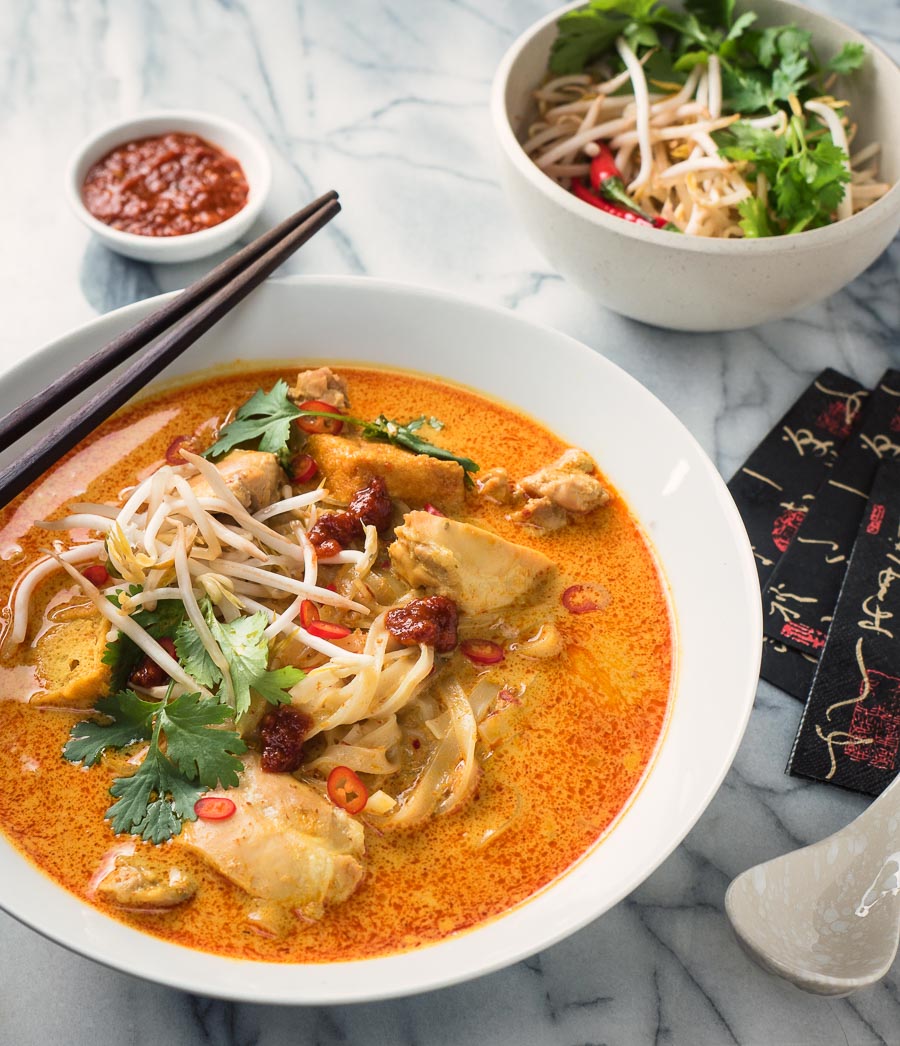
Worldwide Food Tour – Malaysia
Few dishes in Malaysian cuisine are as bold, complex, and soul-satisfying as Laksa—a rich, aromatic noodle soup that embodies the multicultural heritage of Malaysia. This dish is a culinary masterpiece, blending Chinese, Malay, and Indian influences into a bowl bursting with spices, coconut milk, tamarind, and fresh herbs.
Laksa is more than just a soup—it’s a symbol of regional diversity, with each Malaysian state boasting its own unique variation, from the spicy, coconut-rich Curry Laksa to the tangy, fish-based Asam Laksa. No matter the type, Laksa is a dish that warms the soul, excites the palate, and tells the story of Malaysia’s vibrant food culture.
The History: A Fusion of Cultures
Laksa’s origins can be traced back to the 15th and 16th centuries, when Malaysia was a bustling trade hub along the Spice Route. Chinese traders, known as the Peranakan (or Straits Chinese), settled in Malacca and Penang, intermarrying with the local Malay population. Their fusion of Chinese noodle dishes with Malay spices, herbs, and coconut milk gave birth to what we now know as Laksa.
Over time, Laksa evolved into regional variations, each reflecting the local flavors and ingredients of different Malaysian communities. While the dish has since spread to Singapore, Indonesia, and even Australia, Malaysia remains its true culinary heartland.
Types of Laksa: A Bowl for Every Mood
1. Curry Laksa (or Laksa Lemak) – The Coconut-Rich Favorite
A creamy, spicy, coconut-based Laksa that is deeply comforting and indulgent.
Key Ingredients:
✔ Coconut milk – Gives the broth its signature richness.
✔ Laksa paste – A blend of chili, lemongrass, galangal, shrimp paste, and turmeric.
✔ Rice noodles – Typically thick vermicelli or flat rice noodles.
✔ Toppings – Chicken, shrimp, tofu puffs, fish cakes, and bean sprouts.
✔ Garnishes – Hard-boiled egg, fresh herbs, and a dollop of sambal chili.
This version is widely loved in Kuala Lumpur and Singapore, often served with spicy sambal on the side for an extra kick.
2. Asam Laksa – The Tangy, Fish-Based Delight
A bright, tangy, and slightly spicy version made with flaked mackerel and tamarind broth instead of coconut milk.
Key Ingredients:
✔ Tamarind and torch ginger flower – Give the broth a fragrant, sour complexity.
✔ Fish broth – Usually made with mackerel or sardines, adding deep umami.
✔ Thick rice noodles – Chewy and slippery, perfect for soaking up the broth.
✔ Fresh toppings – Cucumber, pineapple, mint, onions, and chili slices.
✔ Shrimp paste (belacan) – A must-have for the authentic, pungent depth.
Asam Laksa is Penang’s most famous dish, ranked as one of the world’s best dishes by CNN Travel. It offers an explosion of flavors, from the rich fishiness to the tangy tamarind and cooling fresh herbs.
3. Sarawak Laksa – The Elegant Borneo Version
A refined, slightly less spicy Laksa from Sarawak (Borneo), Malaysia, known for its balanced flavors and light coconut broth.
Key Ingredients:
✔ A complex broth made with prawns, chicken, and a medley of local spices.
✔ Light coconut milk, creating a silky but not overly heavy soup.
✔ Thin rice vermicelli noodles instead of thick ones.
✔ Prawns, shredded chicken, omelet slices, and bean sprouts.
Sarawak Laksa is less fiery than Curry Laksa but deeply aromatic and flavorful, sometimes called “Breakfast Laksa” due to its popularity in morning markets.
Tasting Notes: A Flavor Explosion in Every Spoonful
No matter the type, a bowl of Laksa is an intense, multi-layered experience:
- Coconut-based Laksas (Curry Laksa, Sarawak Laksa) are creamy, spicy, and slightly sweet, with a deep lemongrass and shrimp paste aroma.
- Tangy, fish-based Laksas (Asam Laksa) offer a refreshing sourness, balanced by the umami of fish broth and the freshness of herbs and vegetables.
- The noodles provide a slippery, chewy texture, whether thick vermicelli or thin rice noodles.
- The toppings—from succulent shrimp to crispy tofu puffs and cooling cucumbers—add layers of crunch, juiciness, and silkiness.
Each spoonful is a perfect harmony of spice, sourness, sweetness, and umami, making Laksa one of Malaysia’s most addictive dishes.
How Laksa is Served and Enjoyed
Laksa is best enjoyed fresh, piping hot, and loaded with toppings.
- A steaming bowl of broth and noodles is served, topped with protein like chicken, shrimp, or tofu.
- Fresh garnishes—mint, chili, cucumber, and onions—are added for crunch and brightness.
- A dollop of sambal chili is mixed in for extra heat.
- A squeeze of lime enhances the tangy and spicy notes.
In Malaysia, Laksa is often eaten at hawker stalls, where locals gather to slurp up the aromatic broth with chopsticks and a spoon.
Beyond Malaysia: Laksa’s Global Popularity
Laksa has spread far beyond Malaysia, finding devoted fans in Singapore, Indonesia, Australia, and beyond. In places like Sydney and Melbourne, Laksa has become a beloved comfort food, often served with a modern twist.
Even in the West, restaurants are now incorporating Laksa’s bold flavors into fusion dishes, such as Laksa ramen, Laksa pasta, and even Laksa burgers!
Why Laksa is One of the World’s Most Beloved Noodle Soups
✔ Bold & Complex Flavors – Each spoonful delivers a perfect balance of spice, creaminess, and tanginess.
✔ Deeply Rooted in Malaysian Culture – A dish that showcases Malaysia’s diverse food heritage.
✔ Versatile – From rich coconut Curry Laksa to tangy Asam Laksa, there’s a version for every taste.
✔ Comforting & Satisfying – Whether for breakfast, lunch, or dinner, Laksa is deeply nourishing.
Laksa isn’t just a dish—it’s an experience that captures the heart of Malaysia’s culinary brilliance.